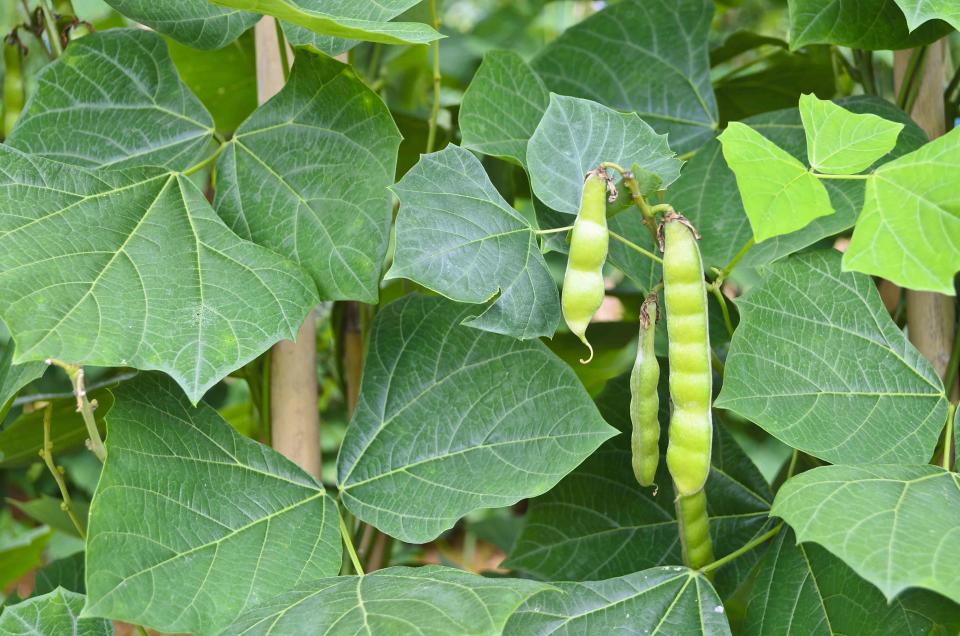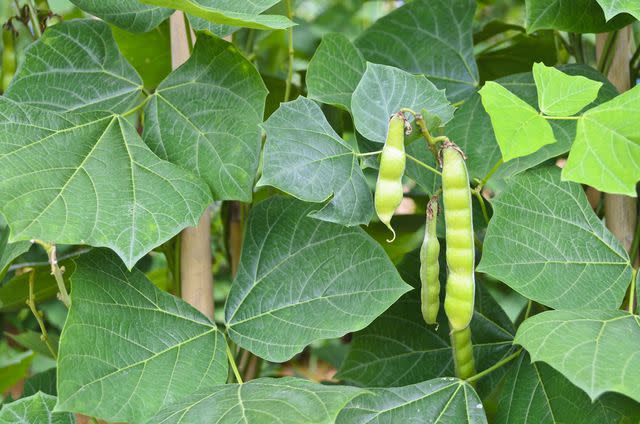How to Plant and Grow Jicama
This sweet root vegetable tastes a little like an apple.

Bentaboe / Getty Images
Jicama, a vegetable primarily grown and eaten south of the border, is fast becoming a snack food and a healthy alternative to fries and chips. With a texture akin to water chestnuts and a sweet, almost nutty flavor, jicama lends itself to both savory dishes and desserts where it's sometimes used as a lower-carb apple substitute. This root vegetable has even made it onto the lunch menu in many schools.
Native to Mexico and Central America, jicama has been cultivated for thousands of years. Jicama grows exceptionally well in tropical zones, where its long vines can reach upwards of 15 to 20 feet. Outside the tropics and subtropics, jicama is frost tender and must be protected for proper growth and harvest.

Bentaboe / Getty Images
Although most jicama is grown commercially in the tropics and subtropics, it can be grown as an annual crop in areas with long, hot summers. Being a day-length sensitive plant, jicama needs a long period of warm weather toward the end of the season when days are shorter than 9 hours before the plants will begin to produce tubers. Protection from frost is vital to harvesting good-sized tubers in colder climates.
Where to Plant Jicama
Jicama grows exceptionally tall in the tropics and will even reach upwards of 10–15 feet when grown in cooler climates as an annual. Plant these climbers where they'll have plenty of sturdy support and lots of room to spread. Although plants do not require as much room at the base, tubers will require ample moisture and nutrients to develop quickly in USDA Hardiness Zones 7-9, making it inadvisable to plant near other crops.
Related: 11 Tropical Plants with Flowers That Will Enliven Any Room
How and When to Plant Jicama
Seeds should be sown indoors upwards of two months before the last frost. This gives plants plenty of time for the seedlings to get a head start on growth prior to hardening off and transplanting outdoors. Give plants protection from pests and wind until vines have grown large enough to support themselves and lessen the risk of snapping off tender shoots.
Care Tips for Jicama
Light
Jicama needs unobstructed full sun for at least 8 hours per day during the growing season. However, to develop tubers, plants must begin to get fewer than 9 hours of light per day to trigger production. Long growing seasons are crucial for these plants to receive enough warmth while the days begin to shorten.
Soil and Water
Jicama vines do best in loamy, well-drained soils with plenty of nutrients and ample moisture. Rich soils will provide plants with access to nutrients necessary for larger roots and better crops.
Be sure to keep the base of the stem and any exposed roots covered with soil. Any exposed portions of the plant (including roots) are highly toxic to both humans and other animals. Do not eat any exposed roots.
Temperature and Humidity
Jicama grows best in hot and humid climates. However, plants can be grown in cooler climates during the summer if started indoors prior to the growing season and not exposed to cold temperatures during tuber production at the end of the season.
Fertilizer
Fertilize jicama plants at least once a month with a high phosphorus fertilizer to assist plants in producing large, tuberous roots. Avoid using fertilizers high in nitrogen, as they will encourage the production of stems and leaves rather than roots.
Pruning
Avoid pruning plants. Robust, healthy vines are necessary for the production of large, edible roots. Pinching back growing tips can help to encourage shorter, wider growth. Deadhead any flowers that are produced to help divert energy into the roots rather than the production of seeds.
Pests and Problems
Due to its toxicity, jicama is not usually bothered by deer or rabbits. Some plants, however, may be attacked by aphids. Spray an insecticidal soap onto the entire plant, above and below the leaves, to control these insects. Treat every few days until aphids are no longer visible.
Harvesting Jicama
From seed, you can expect to be able to harvest your jicama in about 150 days under good conditions, but really, jicama can be harvested at just about any time if tubers are present. Older plants, however, will become hard and woody over time. You can also wait to harvest your crop until after the plants have begun to set seed which can be collected for planting the following season. Please note, however, that jicama seeds are poisonous and should not be eaten!
How to Propagate Jicama
Jicama can be started from seed or grown from small tubers. Sow seeds approximately two months prior to the last expected frost date. Soak seeds overnight prior to planting, then sow them about a half inch below the soil surface and place planted seeds on a warming mat. Seedlings should begin to grow within a couple of weeks and can be planted outdoors shortly after that. Plant seedlings about 8 inches apart.
Alternatively, small tubers from the previous year's harvest can be planted and allowed to grow throughout the growing season. Plant tubers at a depth approximately double their height and allow at least 8 inches between plants.
Frequently Asked Questions
Can jicama be grown indoors?
Jicama grows best outdoors with full sun and a long growing season of at least 8 months. That said, it can be grown with some success in greenhouses or indoors where they receive proper lighting. Plants grown indoors or in pots will tend to produce smaller crops.
Can jicama be grown in pots?
Yes, jicama can be grown in large pots. Pots should be at least 10 to 15 gallons to ensure plants have proper space, moisture, and nutrients.
Is jicama poisonous?
Yes, all above-ground portions of jicama plants are poisonous and should not be eaten. Only consume roots that have been completely covered by soil throughout their growth. Potted plants may lose soil over time, and care should be taken to keep all tubers completely unexposed.
For more Better Homes & Gardens news, make sure to sign up for our newsletter!
Read the original article on Better Homes & Gardens.

